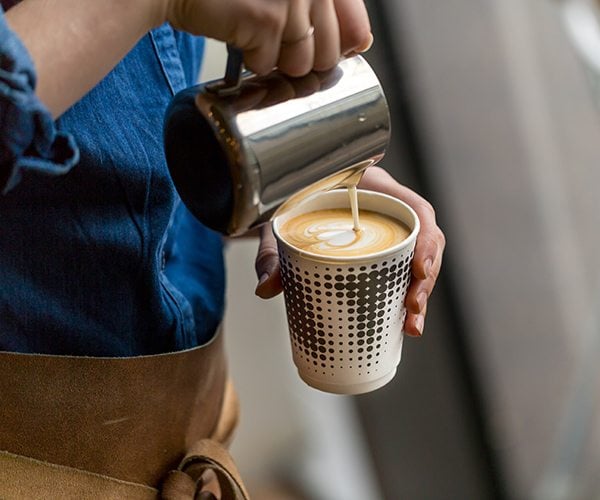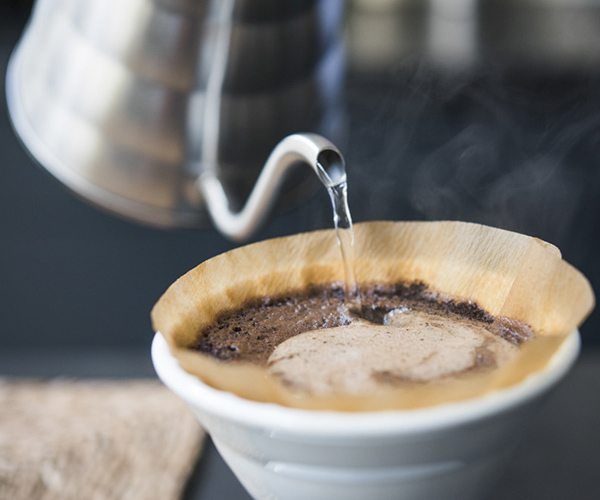What You’re Drinking: Tate Roastery’s Guide to the Best Brew
By Thomas Haigh Head of Coffee by Tate
In coffee there are three main types of brew method: espresso, immersion and filter. Each method creates coffee with different flavours and strengths, so they have very different brewing parameters and recommendations.
The four main parameters to consider when brewing coffee are ratio: the amount of coffee used to the amount of water; Time: how long the coffee is in contact with the water; Water Temperature & Quality: we recommend 93 degrees C for brewing water, and we always recommend filtered water; Grind Size: different brew methods require a certain grind size to determine the brew time and/or extraction percentage, due to the surface area of the ground coffee – this can have a significant impact on coffee extraction and time, and therefore, flavour.
There are other less significant considerations such as agitation, or stirring, pressure, ‘bloom time’ (how long you allow the initial contact with water to release the C02 in the coffee), equipment etc.
Espresso
Espresso coffee forms the base of the majority of drinks you’ll find at your local café. As the drink is small and concentrate, our espresso recipes are strictly adhered to as the room-for-error is small and the ‘sweet spot’ is more allusive.
Ratio: We use a ratio of 1:2 (coffee to water) for espresso. Our typical double espresso uses 17-18g coffee and 34-36g water (we weigh everything for accuracy)
Brew Time: Due to the small surface area of the coffee particles (espresso coffee requires a very fine grind) our brew time for espresso is between 25 and 32 seconds.

Now we can add milk or water to our espresso to create a range of espresso-based drinks…
Cappuccino is made up in ‘thirds’; 1/3 espresso, 1/3 steamed milk, 1/3 foam. These three layers should be textured throughout the drink and the milk should be thick, creamy and glossy, with no apparent bubbles. At Tate we serve our cappuccinos in 8oz cups.
Latte is in a similar size cup to a cappuccino and consists of espresso topped with hot textured milk with just a thin layer of foam. A latte should have the same, glossy finish as a cappuccino, but with less foam.
Flat White will differ depending on where you go for your coffee; we serve our flat whites in a smaller 6oz cup size to accentuate the flavour of our coffee. Traditionally hot, textured milk is added to our double espresso, similar to a latte, but slightly cooler and with less foam.
Macchiato, means ‘stained’ in Italian, and consists of a double espresso touched with a couple of teaspoons of textured milk. This can be ‘dry’ (foamy milk) or ‘wet’ (textured milk) depending on the drinker’s preference.
Filter Brewing
A filter coffee uses some sort of paper or metal filter and gravity to achieve a recipe.
When making filter coffee we use a recipe of 60-65g coffee to 1 litre water and aim to reach a brew time between 2:00 and 4:00 minutes.
Three popular filter systems V60, Chemex or Kalita Wave can be used as a 1 cup (16g coffee to 250g water) or 2 cup method (32g coffee to 500g water). We aim for a brew time of 2:30 minutes for V60 and 3:30 for Chemex, which we can manipulate with our pour rate (how quickly we pour the water into the coffee bed) and grind size. Adjusting the grind texture can ‘speed up’ or ‘slow down’ our recipes.
Immersion Brewing
With an immersion brew method, such as a cafetière or French press, as the coffee is steeped in water for a longer period of time, we use a much coarser grind, to reduce the surface area and prevent over-extraction.
French Press requires a ratio of 17g coffee to 250g water; we aim to steep the coffee for 4 minutes before stirring, plunging and pouring. If your coffee is tasting bitter it may be ‘over-extracted’ and a coarser grind size will be needed; too weak or sour, then we may be ‘under-extracting’ our coffee, requiring a finer grind size to increase flavour.
Immersion brewing coffee is like making a pot of tea – the longer the brew, the more developed and bitter the flavour becomes; the shorter it is, the weaker and more delicate the cup profile becomes.
Header and first body image – photography by Tate Catering/James Munson.
Subscribe to our magazine
Food stories, skills and tested recipes, straight to your door... Enjoy 5 issues for just £5 with our special introductory offer.
Subscribe
Unleash your inner chef
Looking for inspiration? Receive the latest recipes with our newsletter
